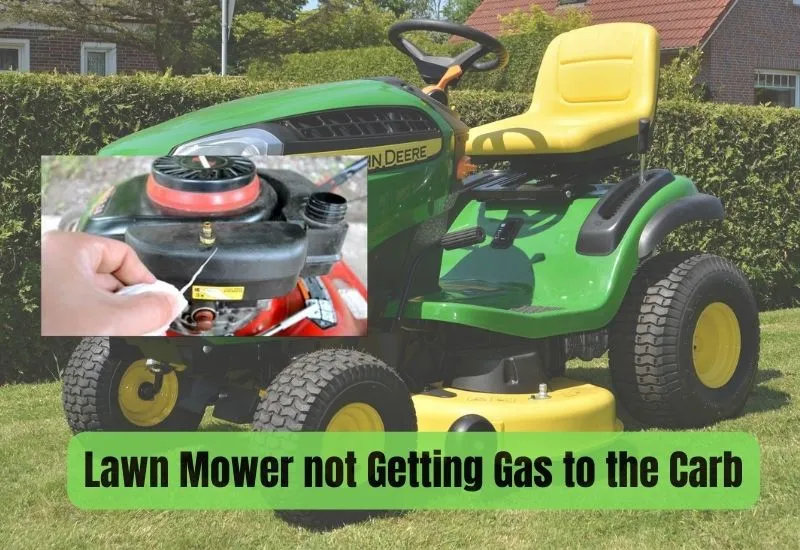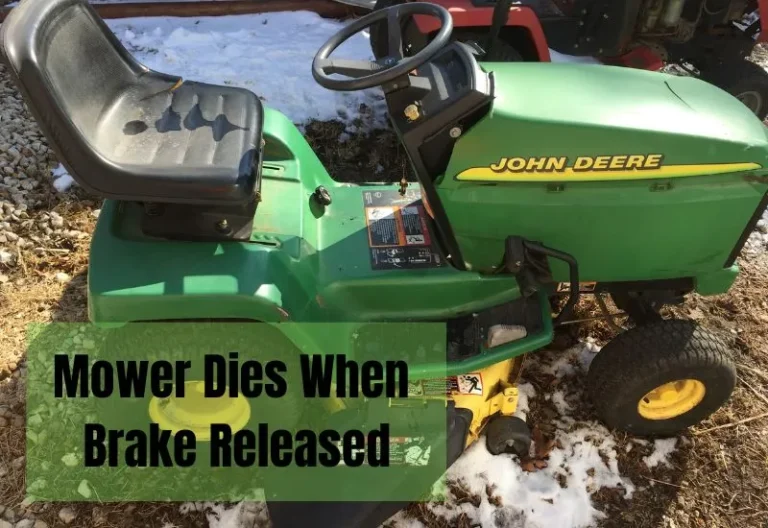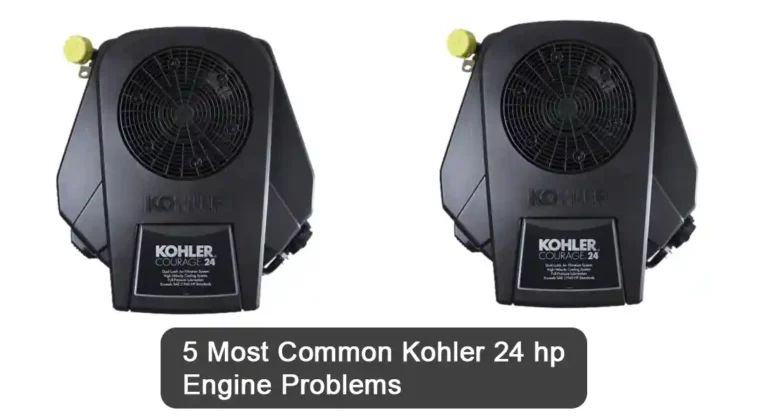6 Reasons Why Lawn Mower not Getting Gas to the Carb
For gas-powered lawnmowers to start, the carburetor must be filled with gasoline. The engine will not start if something inhibits the flow of gasoline. What factors are responsible for this problem? How can we overcome these obstacles?
Since old gas oxidizes fuel components and develops sticky deposits that impede the fuel system, the carb will not receive fuel. It may not receive fuel due to a clogged fuel filter, obstructed or kinked fuel lines, a malfunctioning fuel pump, or a damaged gas cap.
In order to solve the issue, it is crucial to comprehend why this is happening. This article will cover the numerous reasons why a Lawn Mower not Getting Gas to the Carb as well as how to identify and resolve the issue.

6 Most Common Reasons for Lawn Mower not Getting Gas to the Carb
Here is the list of the common causes responsible for Lawn mower not getting gas to the carb and their respective solutions.
| Reasons | Solutions |
| Lawnmower using outdated fuel | Replace the fuel with an appropriate one. |
| Clogged fuel filter | Replace the filter. |
| Defective fuel pump | Cut off the fuel flow and reconnect the gas line to the inlet. |
| Needle or float caught in the carburetor | Clean the Carburetor. |
| Blocked Fuel Flow | Unplug the connection from the tractor and blow the line out by using compressed air. |
| Problematic fuel pressure regulator | Activate the ignition switch using a screwdriver. |
1. Lawnmower Using Outdated Fuel
First, make sure your lawnmower has fuel. Running out of petrol can lead to fuel restrictions that prevent your mower from receiving gas.
Using outdated fuel can make it difficult for gasoline to flow through the carburetors and can block them. Therefore, make sure you are using fresh fuel to avoid developing constraints from continuing to use old fuel.
The majority of gasoline varieties contain ethanol. The combination of water and ethanol will result in the formation of sticky deposits that will clog the fuel system. Your fuel system’s components may prematurely fail due to this mixture as well.
The Fix
To remove the old fuel from the tank, use a syphon pump. Gather the fuel in an authorized fuel container so that you can recycle it later.
Using a petrol stabilization agent is a fantastic strategy for preserving stored oil’s freshness for longer. To balance the gasoline, lower moisture content, and cleanse the fuel system, add fresh fuel combined with a fuel additive.
By lowering oxidation, this treatment will stop fuel degradation. Your fuel will remain more thoroughly clean and fresh.
Note: It’s crucial to use the proper fuel, but it’s also crucial to use the fuel you buy within this time limit because gas can degrade as soon as thirty days after you acquire it.
2. Clogged Fuel Filter
The lawnmower won’t start if the filters are jammed because the fuel won’t get to the spark plug. Fuel system clogs and fuel component damage can result from debris in the fuel system.
The gasoline filter may clog up if you are using really unclean gas or if you haven’t changed it once a year. When this occurs, fuel cannot get to your carburetor through the filter.
The Fix
Replacing the filter and draining the old gas from the petrol tank is the best solution.
Unclog any clogged air filters. An arrow may be seen on the filter’s side. This arrow must indicate the direction of the gas flow when you install the new filter.
The fuel tank should be avoided while the arrow is oriented in the direction of the carb.
3. Defective Fuel Pump
Because the carburetor is located above the fuel tank, the majority of gas-powered lawnmowers have a vacuum fuel pump.
Pressure is created by this kind of pump on the crankcase. That’s why fuel needs to be moved to the carburetor in order to operate uphill. If the fuel pump is defective, the gasoline will not reach to the carburetor.
The Fix
Make sure that fuel is getting to the fuel injection system before inspecting the fuel pump. Cut off the fuel flow. Your fuel pump’s inlet port should be free of the fuel line.
Restart your gasoline flow after putting the connection in a container that is deeper than the fuel tank.
The presence of flow has been established if fuel is flowing from the line into the container. If not, you must locate the obstruction, which could be located in your gasoline filter or fuel lines.
Reconnect the gas line to the inlet after you have made sure that fuel is getting to the pump. The fuel line should be taken out of the carburetor and put in a container.
By beginning the fuel flow and the mower, you can make sure the pump is operating properly. Fuel should be pulsing or flowing continuously from the fuel line. If not, your fuel pump has to be replaced.
3. Needle or Float Caught in the Carburetor
The amount of gasoline in the bowl is controlled by the float needle. If the float or floating needle becomes stuck and prevents fuel from entering the carburetor bowl, the carburetor won’t get fuel.
The Fix
You can try to temporarily remedy this by “unsticking” the float needle by pounding upon that carb with a rubber hammer or the rubber side of a hammer.
This will function for a short while, but eventually, it will need to be taken apart, cleaned, and fixed.
But in the long run, when you encounter a jammed float or float needle, take your carburetor apart to identify the root of the issue.
Cleaning the carburetor can be able to prevent the float from seizing. By removing the fuel bowl and cleaning the carburetor with a cleaner, the issue can be resolved. Your lawnmower’s engine will start up again.
Related Post: 8 Common Lawn Mower Carburetor Problems (Fixes Included)
4. Blocked Fuel Flow
The gasoline shut-off valve, which is found at the base of the petrol tank, allows you to regulate the fuel flow. The lack of a shut-off valve is responsible for blocking the fuel flow to the carburetor.
The Fix
If your lawnmower lacks a shut-off valve, you can crimp the gasoline line to halt the flow by using pinch pliers.
You must stop and restart your fuel flow in order to verify smooth flow from each segment of the line in order to inspect each portion of the fuel system for obstructions.
By using compressed air, blow the line out. Continue until the obstruction is removed and the line is clear. It’s time to change your fuel line if you can’t get the line unclogged or if it is dry and cracked.
5. Problematic Fuel Pressure Regulator
The fuel pressure regulator, which is directly connected to your gas tank, controls how much gasoline is pumped into the carburetor of your two-stroke engine at once.
Incorrect regulation of petrol flow and inability to meet demand are both consequences of a pressure regulator that is not working properly. Your engine will perform badly or stall as a result of the low pressure.
The Fix
You may check to see whether the fuel pressure regulator is broken by taking it out of the petrol tank and starting the engine.
Use a screwdriver or spanner to activate the ignition switch while maintaining pressure on the adjustment valve for the pressure regulator.
The valve ought to turn effortlessly with little effort required. If you can’t turn it on, it probably has to be fixed. You’ll need to hire a qualified mechanic to swap it out.
Frequently Asked Questions (FAQs)
Where is the lawnmower’s carburetor located?
A lawnmower’s carburetor, which contains incoming air and filter, frequently sits on the back or front of the machine which is also joined by the gasoline line.
How can I find out if the fuel is getting to my carburetor?
If your engine has a mechanical fuel pump, fuel should discharge in rapid bursts.
What occurs if a carburetor breaks down?
The fuel economy of your car is directly impacted by a faulty carburetor.
What is the indication of a clogged fuel filter in a lawnmower?
Poor engine performance, difficult starting, sporadic glitches, and fuel pump component failures are all brought on by clogged fuel filters.
Related Posts:
- Fuse Keeps Blowing in Your Lawn Mower? – Troubleshooting Guide
- Lawn Mower Blades Not Engaging: Causes and Troubleshooting Steps
- Resolving Ignition Switch Problems in Cub Cadet – Troubleshooting Tips
- Resolving Slow Spinning Lawn Mower Blades: Troubleshooting Guide
- Why Won’t My Lawn Mower Starter Cord Pull? – Common Causes Explained





